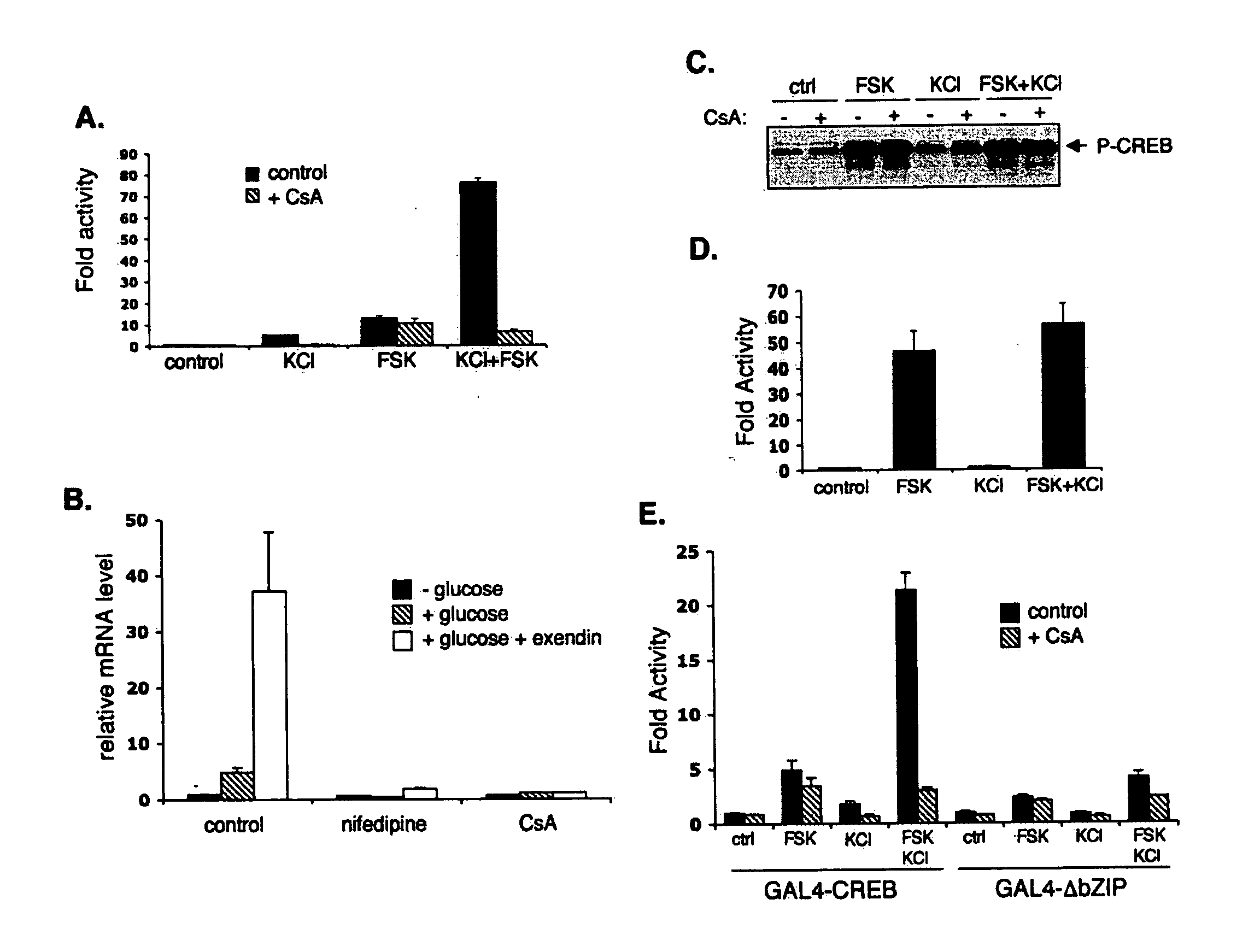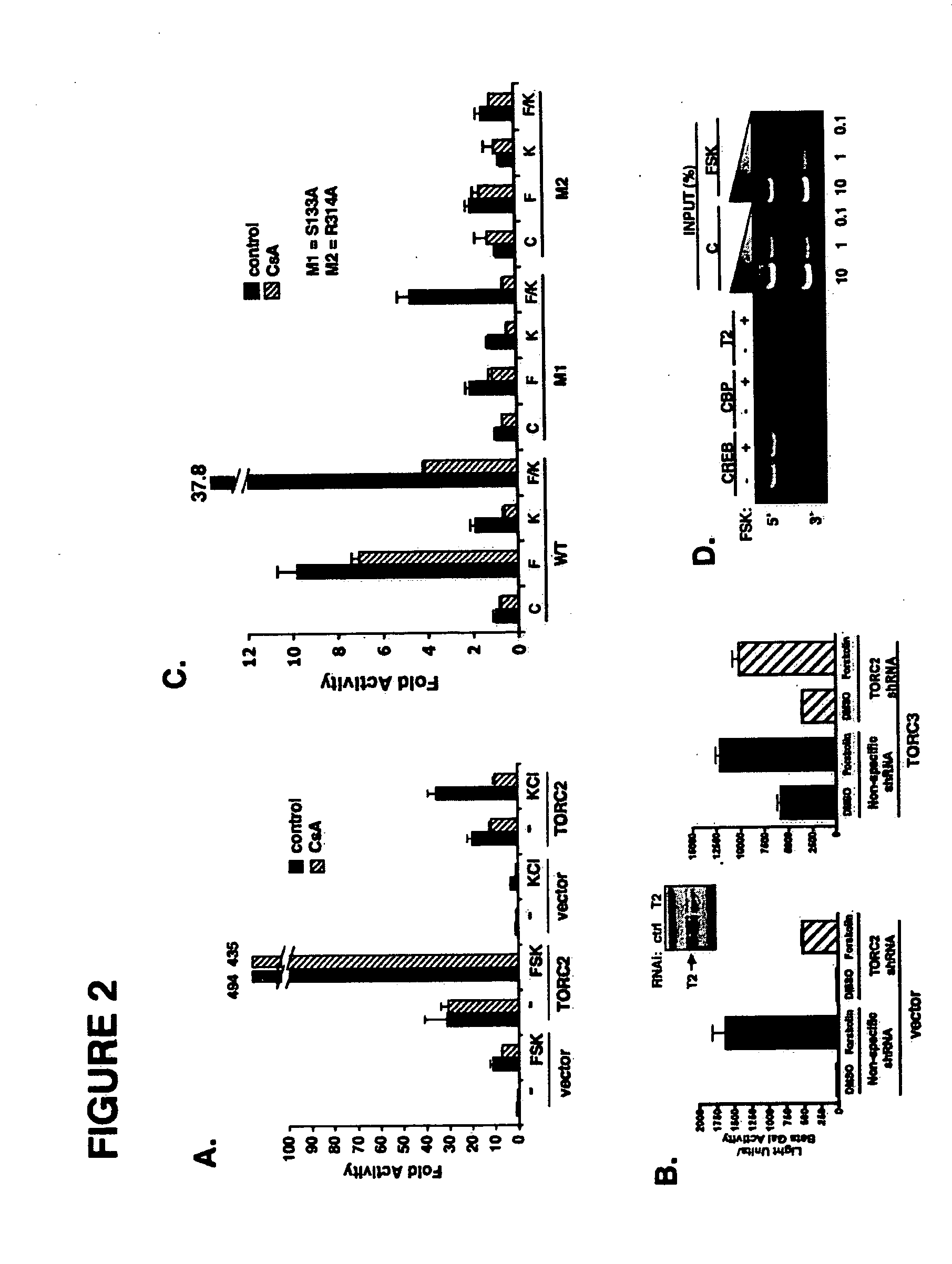Method for screening compounds & uses therefor
a compound and compound technology, applied in the field of methods for screening compounds, can solve the problems of inability of stimuli to promote target gene activation via creb per se, and the identification of such putative coactivator(s) remains elusiv
- Summary
- Abstract
- Description
- Claims
- Application Information
AI Technical Summary
Benefits of technology
Problems solved by technology
Method used
Image
Examples
example 1
A Calcineurin Sensitive Cofactor Promotes Cooperativity between cAMP and Calcium Pathways
[0151] Hamster insulinoma (HIT) cells were employed to test the relative effects of cAMP and calcium signals on CREB activity. Opening of voltage-sensitive L-type calcium channels in response to KC1 depolarization induced the CREB-dependent EVX-1 promoter (Conknight et al., 2003b) 5-fold in HIT cells, whereas addition of cAMP agonist stimulated the reporter 10-fold (see FIG. 1A). Co-stimulation with both forskolin and KC1 stimulated CREB activity 80-fold, demonstrating the cooperative effects of cAMP and calcium pathways on CREB target gene expression in these cells. Pre-treatment with the calcineurin inhibitor cyclosporine A (CsA) blocked cooperativity between cAMP and calcium pathways, indicating that calcineurin performs an important role in modulating CREB activity. Consistent with the effects of calcium channel activity on the EVX-1 promoter, treatment with high glucose (20 mM) induced the...
example 2
TORCs Promote CREB Activation in Response to cAMP and Calcium Signals
[0155] The involvement of the CREB bZIP domain in mediating cooperativity between cAMP and calcium signals prompted examination of the role of TORCs, a family of CREB coactivators which bind directly to the bZIP, in this process. The TORC family comprises three members (TORC1, TORC2, TORC3) each of which contains highly conserved N-terminal CREB binding (aa. 1-42 in TORC1) and C-terminal trans-activation (aa. 517-634) domains (Conkright et al., 2003a; Iourgenko et al., 2003). Over-expression of TORC2 induced basal EVX-1 promoter activity 20-30 fold; and treatment with cAMP or calcium channel agonist further potentiated the reporter 25-fold and 30-fold, respectively, suggesting that TORC2 is regulated by both signals (see FIG. 2A). Consistent with the notion that TORC2 mediates CREB target gene expression via a calcineurin dependent mechanism, addition of CsA disrupted TORC2 activity in HIT cells treated with KC1 (...
example 3
TORCs Migrate to the Nucleus in Response to cAMP
[0161] Immunofluorescence studies were performed to determine the mechanism by which cAMP triggers recruitment of TORC2 to the promoter. The relative absence of cytoplasm in HIT cells for microscopic analysis of TORC localization prompted the use of human ATYB1 fibroblasts. Flag-tagged and endogenous TORC2 proteins were largely confined to the cytoplasm of ATYB1 cells under basal conditions; and treatment with cAMP agonist promoted nuclear accumulation of TORC2 within 30 minutes (see FIGS. 3A and 13). Treatment with the exportin inhibitor leptomycin B (LMB) strongly enhanced nuclear accumulation of both endogenous and transfected TORC1 and TORC2 within 30 to 60 minutes, indicating that these proteins likely cycle in and out of the nucleus in the absence of cellular stimulus (see FIGS. 3B and 13).
[0162] To characterize regions in TORC that promote either cytoplasmic or nuclear accumulation, cellular fluorescence assays were performed ...
PUM
 Login to View More
Login to View More Abstract
Description
Claims
Application Information
 Login to View More
Login to View More - R&D
- Intellectual Property
- Life Sciences
- Materials
- Tech Scout
- Unparalleled Data Quality
- Higher Quality Content
- 60% Fewer Hallucinations
Browse by: Latest US Patents, China's latest patents, Technical Efficacy Thesaurus, Application Domain, Technology Topic, Popular Technical Reports.
© 2025 PatSnap. All rights reserved.Legal|Privacy policy|Modern Slavery Act Transparency Statement|Sitemap|About US| Contact US: help@patsnap.com



